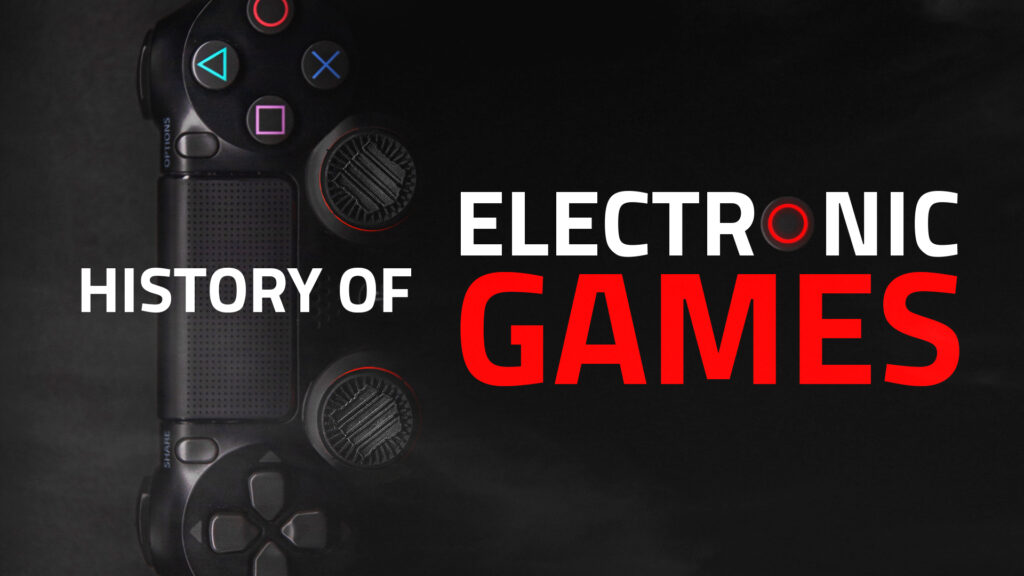Electronic games are the most fun and complex form of entertainment of our time. Often creating a good one is more complicated than shooting a movie or writing a book. Not surprisingly, the sector’s budgets have exceeded those devoted to cinema. However, 70 years of history has taught us that nothing is more important than a brilliant idea.
The pioneers
The birth of video games is linked to the end of World War II. In 1947 the Cathode-Ray Tube Amusement Device was introduced, inspired by the radar screens used during the conflict. Missiles could be launched with a command. Obviously, there were no screens, but a real radar, with stickers to represent the targets.
In 1958, engineer William Higinbotham worked at Brookhaven National Laboratory, a research center of the United States Government. For the laboratory’s annual opening to the public, Higinbotham decided to show visitors something different. He turned an oscilloscope into a game in which a light spot was simulated the bounces of a ball on a tennis court. It was Tennis for two, possibly the first video game ever.
Higinbotham found the possibility of showing the operation of a complex technological tool in a simple and entertaining way interesting. He was not thinking at all about the possible commercial development of his game.
In 1961, Steve Russell, a MIT student, programmed Spacewar into one of the massive DEC PDP-1 computers at the College of Electrical Engineering. What differentiates Tennis for Two from Spacewar is the challenge element present in the second. Spacewar had a spatial setting, as a consequence of the interest towards the typical space of the 1960s.
Spacewar quickly spread to all American universities. For many, it represented the impulse to approach the world of programming. Steve Russel thought about the possibility of marketing his Spacewar, but could not imagine that someone could pay to play with it.
Commercial success
Electronic engineer Ralph Baer in 1966 sensed that America’s 40 million televisions could become excellent tools for gaming. He made a device, the Brown Box, with a ping pong game very similar to Tennis for Two: The Bucket Filling Game. Baer managed to sell his prototype to Magnavox.
Magnavox, in turn, in 1972, launched Odyssey, the first and rudimentary video game console. It was black and white and had no sound. It contained 12 sets and in the box were multi-colored plastic screens that overlapped the television. An external device, a shotgun called the Light Gun, could also be connected. It sold for $ 100 and was not very successful.
Two years earlier, Nolan Bushnell had created Computer Space, similar to Spacewar. The game was sold inside a machine similar to the old pinballs. Computer Space was thus the first arcade video game in history. However, it was too complicated and the public ignored it.
Bushnell did not give up and, in 1972, was inspired by the Magnavox game to create Pong, the most famous game in history. In the same year, he founded Atari. With a starting capital of $ 500, the company grew into a $ 2 billion a year company in less than a decade. Pong launched the golden age of arcades.
In the early 1980s, the first microcomputers arrived to compete with the console industry. The Commodore 64 was sold primarily to an audience of gamers and helped introduce many of them to the world of programming.
Japan’s entry into the scene
In 1978, in Japan, Taito launched Space Invaders. The game was inspired by the title of Atari Breakout. The latter had been made by a young Steve Jobs, in collaboration with Steve Wozniak. Space Invaders was the first video game to introduce narration and it was potentially infinite.
Another decisive step in the development of the Japanese sector was the launch of Pac-Man. Created by Namco in 1980, it was the first video game to feature a character to identify with. In 1981 alone, more than 100,000 machines were sold in a few months, he became a real star.
In those same years, a company that had spent a century in the production of playing cards decided to launch in electronic entertainment. It was Nintendo. The first titles were a failure, until Shigeru Miyamoto, considered the most influential game designer of all time, arrived. He invented Donkey Kong and the so-called platform games, where you had to walk, run, jump or climb on a series of platforms.
1983 is the year of the NES (Nintendo Entertainment System) and of an Italian plumber named Mario. In 1985, the Sega Master System also arrived. The homeland of video games is thus transferred from the United States to Japan.
In 1989, Game Boy, the first mobile gaming platform, which sold more than 120 million copies, also came out of Nintendo. Part of its success is due to Tetris, the game created by Russian mathematician Alexey Pajtnov. The following year, the satoshi Tajiri’s Pokémon, an unprecedented combination of collecting and gaming.
Video games have no limits
In 1994, Sony launched the PlayStation, which in seven years sold more than 110 million models. It is the so-called fifth generation of consoles, characterized by the use of cd-rom instead of cartridges. One of the biggest hits produced for PlayStation was Tomb Raider, in 1996, developed by Core Design. Tomb Raider was the first game to combine adventure and action in a 3D environment.
The 2000s actually started in 1989. When Will Wright created SimCity, the first game that turns everyday life into a spectacular company. Ten years later, in 2000, The Sims arrived, the first simulator of daily life. Thus, video games become a hobby for everyone, conquering even the female audience and those who had never played. In no time, Sims became the best-selling title in history.
2000 is also the year of the sixth generation of consoles. The PlayStation 2 arrived, the best-selling console in history (more than 150 million units). A year later, in the United States, the first Xbox was born, from Microsoft. Both consoles use the DVD and offer an internet connection. In 2006, a year after the Xbox 360 and the PlayStation 3, the Nintendo Wii appeared. This console definitely breaks the barriers of the target audience for video games. Now it is a matter for the whole family.
In recent days
In 2007, the first iPhone was born, which literally takes video games into everyone’s pockets, with such iconic titles as Angry Birds. As of that year, the turnover of the video game industry begins to take off and reaches 100,000 million dollars in 2016.
Today the market looks towards mobile devices and social networks. Facebook is considered the most widespread gaming platform, for phenomena like Farmville.






